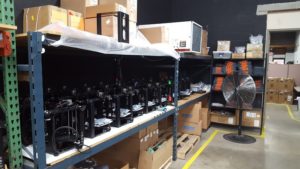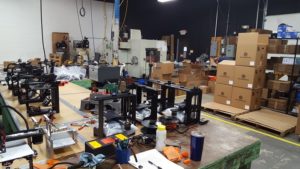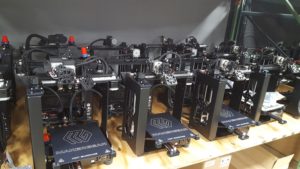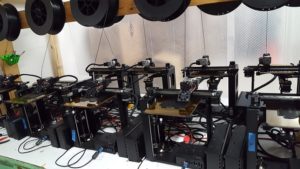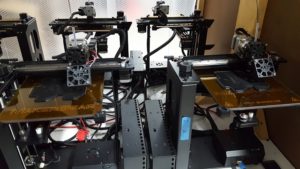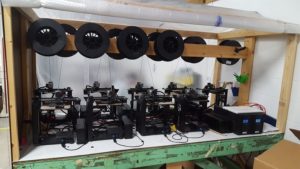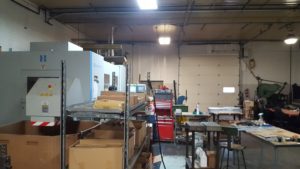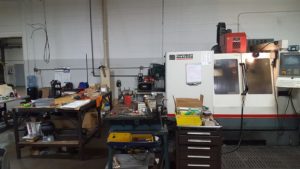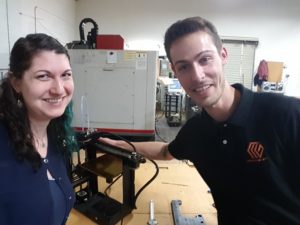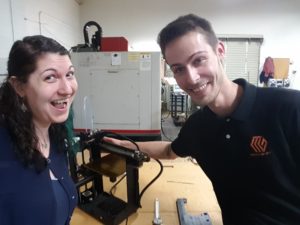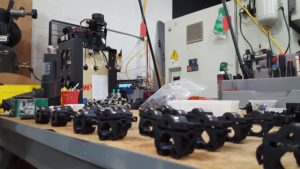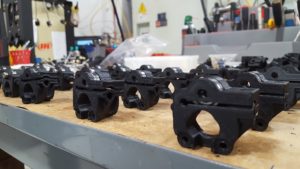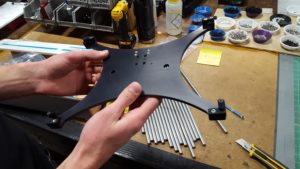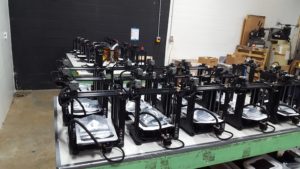 MakerGear, founded in 2009, makes its home on the east side of Cleveland, creating and tweaking and constantly improving their top-ranked desktop 3D printer, the M2. Consistently rated high among desktop 3D printers, the M2 is known as a workhorse, offering consistent quality output and not bogged down with unnecessary bells and whistles (though customization is easy if you prefer the bells… or a dual extruder, higher-end display option, etc.). It has attracted attention for use among creative artists, the US Navy, and even former US President Barack Obama and German Chancellor Angela Merkel. The community built up around the M2 is dedicated, sharing tips and tricks for working with the popular machine. The company behind the 3D printer is dedicated to their community in return — and not just the community of users, but the community where they live and work. Ohio has been turning from its history in the Rust Belt to a hub in the developing Tech Belt, and MakerGear is playing no small role in that transition, with dedicated local production and supplies, including three facilities around the Cleveland area.
MakerGear, founded in 2009, makes its home on the east side of Cleveland, creating and tweaking and constantly improving their top-ranked desktop 3D printer, the M2. Consistently rated high among desktop 3D printers, the M2 is known as a workhorse, offering consistent quality output and not bogged down with unnecessary bells and whistles (though customization is easy if you prefer the bells… or a dual extruder, higher-end display option, etc.). It has attracted attention for use among creative artists, the US Navy, and even former US President Barack Obama and German Chancellor Angela Merkel. The community built up around the M2 is dedicated, sharing tips and tricks for working with the popular machine. The company behind the 3D printer is dedicated to their community in return — and not just the community of users, but the community where they live and work. Ohio has been turning from its history in the Rust Belt to a hub in the developing Tech Belt, and MakerGear is playing no small role in that transition, with dedicated local production and supplies, including three facilities around the Cleveland area.
 Yesterday, I had the opportunity to visit two of those sites to get an inside look at what it is that makes MakerGear tick. Their production facility is located in an unassuming business park in Beachwood, Ohio, where a small central team works seamlessly in a hive of activity surrounded by seemingly endless boxes ready to be filled with tried-and-tested machines, as well as table after table of M2s in a variety of stages of their pre-shipping testing. If it seems that quality control is a big deal here, that’s only the half of it, as my tour guide for the day, Branding & Communications Officer Owen Schoeniger, drew my attention to each stage of QC each individual M2 goes through before it hits the pallet to be shipped off. The parts are checked, the machines assembled, parts tested and tested again in a battery of processes, and then finally hit the shelf where they’ll await their new homes. Each shipment sent out also contains some candy from See’s Candies, which adds a little something extra to be excited about during new machine setup.
Yesterday, I had the opportunity to visit two of those sites to get an inside look at what it is that makes MakerGear tick. Their production facility is located in an unassuming business park in Beachwood, Ohio, where a small central team works seamlessly in a hive of activity surrounded by seemingly endless boxes ready to be filled with tried-and-tested machines, as well as table after table of M2s in a variety of stages of their pre-shipping testing. If it seems that quality control is a big deal here, that’s only the half of it, as my tour guide for the day, Branding & Communications Officer Owen Schoeniger, drew my attention to each stage of QC each individual M2 goes through before it hits the pallet to be shipped off. The parts are checked, the machines assembled, parts tested and tested again in a battery of processes, and then finally hit the shelf where they’ll await their new homes. Each shipment sent out also contains some candy from See’s Candies, which adds a little something extra to be excited about during new machine setup.

They made me promise to note that these boxes are empty, and it does in fact matter which way is up when there’s a printer in the box.
As we walked among the shelves of 3D printers, we were joined by Founder and CEO Rick Pollack for a quick chat in the busy day. Following a recent discussion in a 3D printing group on Facebook, and surrounded by shipments waiting to happen, I asked Pollack about shipping for the company, as several (non-MakerGear) customers had recently shared horror stories online about mishaps in receiving 3D printers they had ordered, dumped unceremoniously down stairs or tossed onto porches for delivery. That hasn’t been much of a concern for them, Pollack told me, as their shipments have all seemed to make it safely — but they have had some concern about Internet fraud, as any company operating online does. As Pollack was able to name only a couple of scenarios offhand, however, it’s clear that these unfortunate occurrences are certainly far from the norm. MakerGear is maintaining vigilance against fraud these days, so criminals beware.
Moving away from the ready-to-ship machines, Schoeniger and I continued our look at the testing stations, as he pointed out various components ready to be installed on the machines, many of which are themselves 3D printed on a line of M2 3D printers whirring away at a workstation near the desk space in the front of the offices. Nine linked M2s are constantly at work, 3D printing more ABS parts in a semi-enclosed work area, linked together through OctoPrint on a single computer. The multitude of 3D printed 3D printer parts comes in handy for both customer and manufacturer, as parts can be upgraded or customized — or even replaced, as Schoeniger told me of the trip to Germany last year when an M2 needed for their showing there required a new shroud, which after a quick visit to GitHub they were able to create in time for the show. The ease with which parts can be replaced and fixed comes in handy, as numerous examples prove; another case Schoeniger touched on was a recent trade show where a booth was showing off a professional, $10K+ 3D printer… but couldn’t have it printing onsite due to a clogged nozzle, which would be too complicated to remove, clean, and refit on the show floor. An M2 took its place so that booth could still show active 3D printing.
Accessibility is an important consideration for MakerGear, as the workhorse mentality for the M2 remains in sight. The desktop 3D printer may not be the most beginner-friendly on the street, but it also isn’t terribly difficult to learn.
“We don’t resort to complexity unless it’s absolutely necessary,” Schoeniger told me. “We stick to the KISS theory — keep it simple, stupid. It’s a simple, accessible approach. 3D printing isn’t just about layer height and how many extruders your machine has. We see it as actually giving a professional-level experience without costing an arm and a leg.”
Comparing their 3D printers to cars, Schoeniger pointed out that while an automatic transmission may make a car easier to operate than a standard, there’s just that much more that can go wrong with it. The M2 isn’t exactly automatic, but that keeps operations smoother functioning.
“This can be your first 3D printer, but it can also take you farther. These are used at Tri-C [Cuyahoga Community College], where students are not afraid to walk up to these, like they are with higher-end machines, and they can still get done all they need to do,” Schoeniger said. “It’s interesting that the same unit can be used for kindergartners to print musical instruments they design on Tinkercad and for professional engineers creating tooling.”
The M2 does not feature an enclosure, which may seem concerning for use in kindergarten classrooms, but Schoeniger points out that many educators have said the openness is actually a benefit, as students can see up close exactly what’s happening in the process — though of course a physical barrier between the youngest students and the machine is recommended to keep small hands away from hot components.
 Schoeniger and I next went over to Novelty, about a 30-minute drive, to visit the team at the R&D facility. Geauga County, Ohio has a strong history in manufacturing, and Todd Zeitz has been in the same building since 2000 with Geauga Machine & Tool; however, as the ups and downs in the industry weren’t always kind to smaller manufacturing operations, times were tough for a while. For about five-eight years, GMT operated primarily as a job shop — until Zeitz met MakerGear at a BattleBots show at Lakeland Community College and got to talking with Pollack. Zeitz, who has a background in tooling and has been in the business since 1995, became interested in 3D printing, building his own first machine through a SeeMeCNC kit a few years back, and fell in love with it. Working now with Pollack in creating parts for MakerGear, Zeitz noted that he’s “now making 3D printers day in, day out; it’s a great industry, and I love being part of it.”
Schoeniger and I next went over to Novelty, about a 30-minute drive, to visit the team at the R&D facility. Geauga County, Ohio has a strong history in manufacturing, and Todd Zeitz has been in the same building since 2000 with Geauga Machine & Tool; however, as the ups and downs in the industry weren’t always kind to smaller manufacturing operations, times were tough for a while. For about five-eight years, GMT operated primarily as a job shop — until Zeitz met MakerGear at a BattleBots show at Lakeland Community College and got to talking with Pollack. Zeitz, who has a background in tooling and has been in the business since 1995, became interested in 3D printing, building his own first machine through a SeeMeCNC kit a few years back, and fell in love with it. Working now with Pollack in creating parts for MakerGear, Zeitz noted that he’s “now making 3D printers day in, day out; it’s a great industry, and I love being part of it.”
Through the facility in Novelty, MakerGear now doesn’t have to go to another vendor, leading to significantly shorter turnaround in sampling new materials, creating new prototypes, and working on enhancements and tweaks to their machines. The original M2 was introduced in 2012, and the fifth-generation model contains more than 50 incremental improvements made over the last five years; tweaks and improvements can now come even faster with the close turnaround, as this facility makes 8-10 parts for the M2: “The most critical parts,” as Schoeniger put it. The operations at this facility is only three men, but it creates a sense of close teamwork, ensuring that all the same values are operating throughout with a “very homegrown” mentality of dedication.
“Everyone who works here works hard, making sure nothing gets past us,” Zeitz said of the team.
During my day with MakerGear, conversation often came back to values. The company values workhorse performance in the machines they put out, which can only come together thanks to standardized high expectations across the board. As Pollack notably loves the sleek appearance of sturdy black metal, the team works to create machines that will last and will meet his high standards. With the value placed on homegrown ties, we also see significant links across Ohio — Zeitzer and Pollack are both graduates of the University of Cincinnati; many machines in the R&D shop are from Cincinnati Milacron; Simplify3D software that MakerGear favors is based near Cincinnati; even See’s Candies has a Beachwood location. Keeping operations and production within a limited geographic area ensures that a close eye can be kept at all times on all parts of the company, lending a strong sense of team spirit as everyone at MakerGear shares a bond as a community in themselves, striving to not only create a powerful product, but to offer support and enhancements for it in a constant cycle of self-aware improvement.
We’ll be following up soon with an interview to learn more about MakerGear’s history, aspirations, and thoughts on the industry. Below are some more photos from MakerGear’s operations:
- Me, an M2, and Owen at the R&D facility
Interested in having 3DPrint.com visit your site? Let us know! Drop me an email any time. We love to see where the technology we write about comes to life, and to meet the teams behind the news!
[All photos: Sarah Goehrke for 3DPrint.com]
Subscribe to Our Email Newsletter
Stay up-to-date on all the latest news from the 3D printing industry and receive information and offers from third party vendors.
You May Also Like
Gorilla Sports GE’s First 3D Printed Titanium Cast
How do you help a gorilla with a broken arm? Sounds like the start of a bad joke a zookeeper might tell, but it’s an actual dilemma recently faced by...
Nylon 3D Printed Parts Made More Functional with Coatings & Colors
Parts 3D printed from polyamide (PA, Nylon) 12 using powder bed fusion (PBF) are a mainstay in the additive manufacturing (AM) industry. While post-finishing processes have improved the porosity of...
$25M to Back Sintavia’s Largest Expansion of Metal 3D Printing Capacity Since 2019
Sintavia, the digital manufacturing company specializing in mission-critical parts for strategic sectors, announced a $25 million investment to increase its production capacity, the largest expansion to its operations since 2019....
Velo3D Initiates Public Offering in a Bid to Strengthen Financial Foundations and Drive Future Growth
Velo3D (NYSE: VLD) has been among a number of publicly traded 3D printing firms that have attempted to weather the current macroeconomic climate. After posting a challenging financial report for 2023,...


